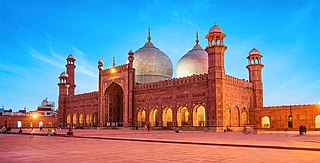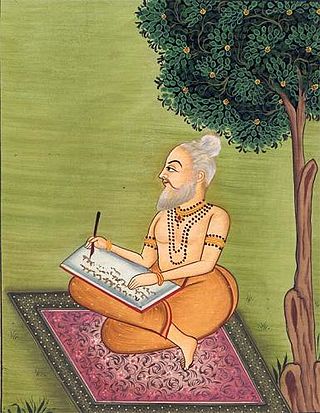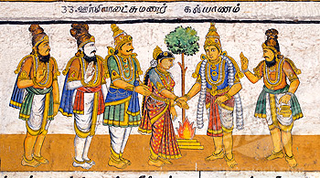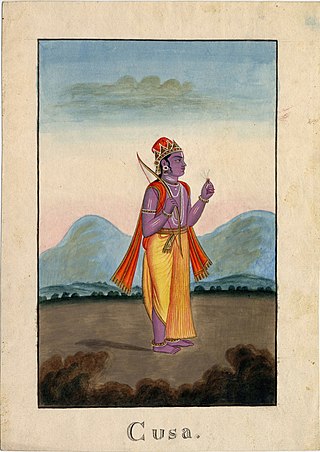
The Ramayana, also known as Valmiki Ramayana, as traditionally attributed to Valmiki, is a smriti text from ancient India, one of the two important epics of Hinduism known as the Itihasas, the other being the Mahabharata. The epic narrates the life of Rama, a prince of Ayodhya in the kingdom of Kosala. The epic follows his fourteen-year exile to the forest urged by his father King Dasharatha, on the request of Rama's stepmother Kaikeyi; his travels across forests in the Indian subcontinent with his wife Sita and brother Lakshmana; the kidnapping of Sita by Ravana, the king of Lanka, that resulted in war; and Rama's eventual return to Ayodhya along with Sita to be crowned king amidst jubilation and celebration.

Lahore is the capital and largest city of the Pakistani province of Punjab. It is the second largest city in Pakistan, after Karachi, and 26th largest in the world, with a population of over 13 million. Located in north-eastern Punjab, along the River Ravi, it is the largest Punjabi-speaking city in the world. Lahore is one of Pakistan's major industrial, educational and economic hubs. It has been the historic capital and cultural centre of the wider Punjab region, and is one of Pakistan's most socially liberal, progressive, and cosmopolitan cities.

Valmiki was a legendary poet who is celebrated as the traditional author of the epic Ramayana, based on the attribution in the text itself. He is revered as Ādi Kavi, the first poet, author of Ramayana, the first epic poem.

Sugriva, is a character In the ancient Hindu epic Ramayana. He is the younger brother of Vali, whom he succeeded as ruler of the vanara kingdom of Kishkindha.He is a son of Surya, the Hindu deity of the sun. Later He married to Vali's wife, Tara and adopted their son, Angada. As the king of the vanaras, Sugriva aided Rama in his quest to liberate his wife Sita from captivity at the hands of the rakshasa king Ravana.

Kasur is a city to the south of Lahore, in the Pakistani province of Punjab. The city serves as the headquarters of Kasur District. Kasur is the 16th largest city in Punjab and 24th largest in Pakistan, by population. It is also known for being the burial place of the 17th-century Sufi-poet Bulleh Shah. It is farther west of the border with neighboring India, and bordered to Lahore, Sheikhupura and Okara Districts of Punjab. The city is an aggregation of 26 fortified hamlets overlooking the alluvial valleys of the Beas and Sutlej rivers.

Lava and his elder twin brother Kusha, are the children of Rama and Sita in Hindu tradition. Their story is recounted in the Hindu epic, Ramayana and its other versions. He is said to have a whitish golden complexion like their mother, while Kusha had a blackish complexion like their father.

Sita, also known as Siya, Janaki and Maithili, is a Hindu goddess and the female protagonist of the Hindu epic Ramayana. Sita is the consort of Rama, the avatar of god Vishnu, and is regarded as an avatar of goddess Lakshmi. She is the chief goddess of the Ramanandi Sampradaya and is the goddess of beauty and devotion. Sita's birthday is celebrated every year on the occasion of Sita Navami.

Urmila, is a Hindu goddess and the princess of Videha in the Hindu epic Ramayana. She is considered to be an avatāra of Nagalakshmi, the serpent goddess. Urmila was married to Lakshmana and is known for her dedication towards her husband, for her courage and sacrifice.

Shrutakirti is a princess of Videha, in the Hindu epic Ramayana. She is the wife of Shatrughna and is considered an incarnation of the disc of goddess Lakshmi. Shrutakirti is known for her foresight and dedication.

Mandavi is a princess of Videha in the Hindu epic Ramayana. She is the wife of Bharata and is considered an incarnation of the conch shell of goddess Lakshmi. Mandavi is known for her sacrifice and perseverance.

Kusha and his younger twin brother Lava were the children of Rama and Sita. Their story is recounted in the Hindu epic, the Ramayana. Hindu traditions claim he ruled the entire region of Kashmir, Indus River and Hindu Kush as frontier lands of India known as Hindu Kush Kshetra and founded the city of Kashmir in the valley and Kasur with Lavapuri of Lava in base lands, though local lore contends Kasur was founded in 1525 by Pashtun migrants. His brother Lava is traditionally believed to have founded Lavapuri.
Ihsan H. Nadiem is a Pakistani archaeologist, museologist, author and poet.

Bala Kanda is the first Book of the Valmiki Ramayana. The Bala Kanda, in part—if not in its entirety—is generally regarded as an interpolation to the original epic.

Guzgan was a historical region and early medieval principality in what is now northern Afghanistan.
The Tamsa River is a tributary of the Ganges flowing through the Indian states of Madhya Pradesh and Uttar Pradesh.

A Hindu legend based on oral traditions holds that Lahore, known in ancient times as Nokhar , was founded by Prince Lava, the son of the goddess Sita and Rama; Kasur was founded by his twin brother Prince Kusha. To this day, Lahore Fort has a vacant Lava temple dedicated to Lava. It is one of various etymological theory of Lahore's origin.
Kurungaleeswarar Temple is a historically important Hindu temple in the neighbourhood of Koyambedu, Chennai, India. The temple encloses a large tank and dates from the Medieval Chola period.

Lav Kush is a 1997 Indian Hindu mythological film, produced by Dilip Kanikaria under the Devyank Arts banner and directed by V. Madhusudhana Rao. It is based on Valmiki's Uttar Ramayan from the Indian epic Ramayana. The music of the film was composed by Raamlaxman. It stars Jeetendra as Rama, Jaya Prada as Sita, Arun Govil as Lakshmana, Dara Singh as Hanuman and Pran as Valmiki.

Lava Temple is a Hindu place of worship dedicated to the Hindu deity Lava, the son of Rama. It is in Lahore Fort, Lahore, Pakistan, and dates to the Sikh period. According to a Hindu legend, Lahore is named after him.

Born as Zeb-un-Nisa, Dai Anga, was the wet-nurse of the Mughal Emperor, Shah Jahan. Her family was closely associated with the Mughal empire. Her husband Murad Khan served in the court of Emperor Jahangir as Magistrate of Bikaner, and her son Muhammad Rashid Khan, was the best archers in the kingdom, and died fighting in the service of Shah Jahan's eldest son Dara Shikoh.

















